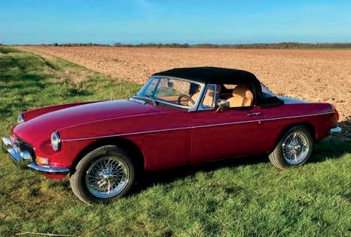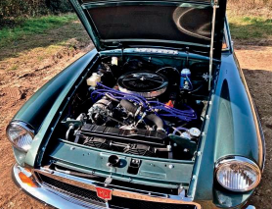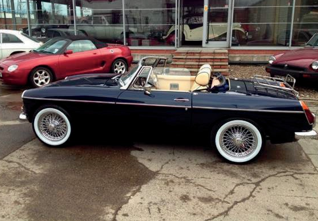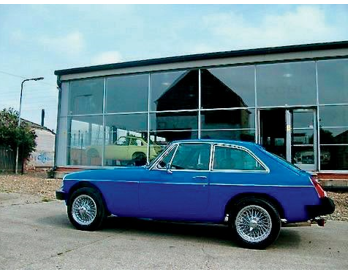MGB – To B or not to B?
Introduction
![]()
- The MGB Specification Guide: introduction
- The MGB from the Very Beginning
- The Origins of the MGB
- A brief history of MG and its owners
Introduction
Chapter 1
The MGB, for many, the affordable classic sports car that in theory should need no introduction, I imagine we have all seen or heard, sat in, driven or stared lovingly at an MGB at some point in our lives.
From early experiences of driving to fond memories of friends or relatives owning one, to the all too familiar tale of parting ways with a cherished MG to make way for a family-friendly car with more seats. Or to be used as a deposit for a new home, people interested in 60’s & 70’s cars will at some points have been involved to a large or small extent with an MGB, and this is where our story begins.
I hope you enjoy this journey as we delve into the history and the specification changes of the MGB, the records that were kept were very different from today. Therefore, we are somewhat reliant upon information supplied when pen and paper ruled, long before computer systems took over.
The MGB was, and still is a driver’s car. Unlike modern cars, they have to be used and driven to fully appreciate their charm. These cars have a real soul and when used and enjoyed instil the feeling of genuine interaction with a machine which very few, if any modern cars can offer.
Often they were undervalued at the time of purchase. Their real beauty and worth went unnoticed until much later in life when you sit back and appreciate what they were. What fun one had owning and driving a real iconic game-changer of a car.
The MGB saw many changes over the years, some to merely update the car and keep it fresh, others were more radical to cater for the various markets they were destined for. The car’s designer Syd Enever managed to create a car which was much more robust and stiffer than its predecessor the MGA, this helped to enhance the handling of the car and made it a very sturdy and safe vehicle of its time.
All the information in this book has been researched from many, many sources. My aim is to be as accurate as possible using all the information at my disposal, As with nearly all car production runs, they evolved over some time, the MGB was no different, throughout this book, we will be looking at changing consumer attitudes and how cars were used and driven.
The changes to the MGB were not only to improve the car but also to keep pace with the general public’s requirements and be on a par with regulations. The largest change was the introduction of the rubber bumper model with the increased strength and new materials required to satisfy North American regulations, they were the MGB’s biggest market.
My own interest in the MGB started many years ago when I fondly remember my first dramatic experience driving a 1966 MGB GT finished in Tartan red in wet and windy conditions.
As most of my early driving was done primarily in front-wheel-drive cars, I found the rear-wheel-drive car on a wet roundabout one Sunday morning quite an eye-opener. With a little too much throttle I ended up nearly facing the wrong direction, I managed to correct the car and drove off somewhat nervously but with a smile on my face which I still get today when driving a well prepared MGB to the high standards here at CCHL.

A CCHL MGB Roadster finished in Damask red fitted with 15” chrome wire wheels and a Mohair hood

Green CCHL MGB V8

Cream CCHL MGB Roadster with wire wheels and Red Soft top

Dark Blue CCHL MGB Roadster with wire wheels and white wall tyres
Ever since then I have driven many MGB’s from very standard factory specification cars to highly modified examples, but they all portray the same characteristics from this much loved and respected model of simplicity.

MGB Roadster, this model is finished in metallic Jaguar Blue and fitted with larger 15” chrome wire wheels and a blue Mohair hood. Still retaining the classic look with a little modern twist.
It has a sure-footed and predictable feel making you confident about the capability of the car.
I hope I have described most, if not all of the significant production changes and alterations that have been included in the following pages. As you can imagine over an 18-year production run there were many modifications and improvements from minor tweaks to some radical overhauls, all of which, resulted in the car we all know, and for most of the time love so much today.
The MGB from the Very Beginning
The MGB was introduced in 1962 as a replacement for the beautiful but dated MGA, the aim was to update and build on the predecessors’ success and include more features to keep pace with other car manufacturers of the time and also to make the car more usable on a daily basis.
The whole design of the car was radically changed, not just with the monocoque body but also with the addition of wind-up windows, a more powerful engine and an improved gearbox.
The factory had to devise something to rival its competitors, and with that, the MGB was born. Initial reaction was good, but not even MG were aware of the impact that their new model would have on the company. Indeed, how it would become one of the best-loved British sports cars of its era, still popular today, the car maintains a huge following.
Its ease of driving along with the attractively designed bodywork with a chrome strip runnning the full length of the body gives the MGB its defining look, which is quite simply timeless. Over the full production period of the MGB from May 1962 until it ceased in October 1980, just over 512,000 cars were built with a large proportion destined for the North American market.
The MGB Roadster was unveiled first; it was then followed by the GT model with production starting in September 1965.
Both cars were easily recognised, the GT version, a Coupe, shared many of the same mechanical components but with new body panels to supplement the flowing lines.
The GT was a more practical and usable example having the added benefit of a small rear seat for occasional use if needed, providing you could squeeze into this small area.
The Origins of the MGB
Whilst the exterior style of the new roadster, known by its BMC project number of ADO23, was almost completed by 1959, its mechanical details were still work in progress. Both Abingdon and BMC management hoped to make the ADO23 a much more sophisticated package compared to the MGA. Abingdon had high hopes for the project which involved updating the MGA’s antiquated suspension.
The MGA’s front suspension was the same as the Y-type saloon, old-style lever shock absorbers and a simple live rear axle on leaf springs. Several engineers and many drivers criticised the MGA’s handling especially at speed.
Since the rear springs had the sole responsibility for the axle location, they were made very stiff. This was fine on a smooth track, but not so great on everyday roads where the harsh suspension and high unsprung weight caused the ride to be too firm and in fact quite uncomfortable.
There was a great deal of room for improvement to make its successor a user-friendly vehicle that it had to be. They had to ensure it was a success from the start so big things had to change.
John Thornley, the General Manager of MG at the time, very much wanted the ADO23 to be ready before the end of the ’50s, but with various delays in the construction of the first full usable prototypes, it was not ready until the spring of 1960. Coupled with the fact that they were not ready for full testing until autumn of that year the timing of the cars fell well behind the anticipated schedule.
During this time Abingdon launched the MGA 1600 Mk 2, this was a stop-gap to try to keep the interest alive while work continued on the MGB. As John Thornley had initially suspected the MGA sales lost ground rapidly in the early 60’s. Many buyers pivoted towards its rivals such as the Triumph TR4, it then became apparent that the replacement had to be ready sooner.
One of the last MGA roadsters, the MGA 1600 Mk 2 was Introduced in June 1961 with an increase in engine size to 1,622cc producing 90 Bhp, Other improvements were a headlamp flasher switch, wheel trims, closer ratio gearbox, an anti-roll bar and battery covers.
However, this could not win back enough new buyers, and MG knew they had to act fast and introduce the all-new replacement.
The spruced-up MGA was not a great sales success, for all the reasons they already knew and were trying to remedy with the MGB.
The Launch of the MGB
The MGB was launched in 1962 and was hailed a great success. It was aimed directly at the US market. The car was praised not only for its modern design but also for the improved space inside and the notable upgrade the engine and gearbox enhancements gave along with better weather gear and overall ease of use.
It had some big boots to fill taking over from the MGA, however, it looked as though MG had pulled it off with journalists and buyers all giving positive reviews. The comments proving the bold move of making the car a stronger and comfortable machine in comparison to the MGA had paid off.
The sales figures proved the MGB was a hit and continued showing no signs of slowing down for the first few years; the introduction of the GT in 1965 cemented its status as a desirable yet affordable sports car of the ’60s.
Not until 1967 did sales start to slow, this was a trend that continued for a few more years until the refreshed model was introduced in 1970.
This brought new buyers who bought into the updated offering even if the die-hard enthusiasts were not as supportive. They did not like the idea of vinyl seats and rubber-faced over-riders and a completely revised recessed front grille, all in all there were mixed reactions.
Overall the MGB was a commercial success, quickly overtaking the early MGA for sales. The MGB’s 25,000 plus annual sales were fairly modest in comparison to some, but it was the best-selling model Abingdon had ever offered. It showed they were still capable of producing a car to compete with its rivals.

The pure lines of the MGB GT with Old English White paintwork show the timeless beauty of the car, this example also has 15” chrome wire wheels.
A major factor of the MGB’s popularity was the price. This was a desirable proposition for many, especially when compared to the likes of Jaguar and Triumph. In the UK, the price started at £949, £60 cheaper than a very basic Triumph TR4.
Fortunately for British car buyers, the Chancellor of the Exchequer cut the tax rate significantly just weeks after the MGB’s introduction, by the 1964 model year, the advertised price had fallen to £836 this included purchase tax even though the base price had not changed. Just like the MGA, most MGBs were sold abroad. North America took the lion’s share with the bulk of production, but the MGB also sold well in other countries. To avoid import charges, MG developed CKD (completely knocked down) kits that were to be assembled locally in Ireland, Belgium and Australia; more than 9,000 MGB roadsters were built between 1962 and 1972.
The most significant changes for the MGB occurred in 1974 when, whilst still retaining its overall silhouette, the shape was marred by the change of large black rubber bumpers, for many this was the decline of the MGB as we know it. The major factor for this addition was the North American market which pretty much dictated what was going to happen with the MGB as it was the largest single buyer of the car.

MGB GT in a very 70’s colour scheme
Raising the ride height by one inch and removing the shiny chrome bumpers with heavy and large black rubber offerings was to enable the car to comply with stricter crash regulations for the US. The car was too long in the tooth to redesign completely, and a new model was out of the question, so the only way forward for British Leyland was to modify and adapt what they had. In fairness, it still sold reasonably well until the late ’70s and figures remained fairly consistent. The car that had essentially the same body shell and lines for nearly two decades was now showing its age.
It was starting to look dated in what was becoming a hot hatch market. Tastes were changing and were reflected in the likes of the Mk1 Golf GTi. There was a movement away from two-seater sports cars to a larger, more refined market for people who wanted a practical hatch with sportier credentials.
A brief history of MG and its owners.
The company’s name is thought to have originated from the initials of Morris Garages, discussion continues as to when the MG Car Company initially started.
The earliest cars to use the Morris and MG badges appear to be around November 1923. The MG Octagon was first registered as a trademark by Morris Garages on May 1 1924, with its 90th anniversary celebrated in 2014. The very first cars were re-bodied Morris models that used the coachwork from Carbodies of Coventry.
Morris Garages built these cars in their premises in Alfred Lane, Oxford. Demand soon built up which saw a move to larger premises in Bainton Road in September 1925. They were now sharing workshop space with the Morris radiator works.
Further expansion did lead to yet another move to a separate factory in Edmund Road, Cowley, Oxford in 1927. It was near the main Morris factory, and for the first time, it became feasible to include a proper production line.
In 1928, the company had yet again grown. It was also big enough to need an identity separate from the original Morris Garages. To help build on its success and grow the brand; the MG Car Company Limited was established in March of that year.
Once more space ran out, and another search for a more permanent home led the search to an old leather factory in Abingdon, Oxfordshire. In 1929 they were able to lease a large section and then gradually take over more space over time until production finally ended there. A Mr. William Morris owned MG initially; MG was sold during 1935 to Morris Motors who were incorporated as WRM Motors Limited, later called the Nuffield Organisation.
In 1952 MG, Morris Motors Ltd and the Austin Motor Co were merged to form the British Motor Corporation Limited.
The service manager John Thornley took control as general manager, and under his influence, he navigated the company through its best years until he retired in 1969. Under the umbrella of the British Motor Corporation, several MG models were merely re-badged and engineered versions of other established marques, with the main exception of this rule being the MG sports car division.
BMC also took over Jaguar Cars in September 1966 and in December BMC changed its name to British Motor Holdings. It joined forces with Leyland Motor Corporation in 1968 to form British Leyland Motor Corporation (BLMC). Then, following partial nationalisation in 1975, BLMC became British Leyland which was eventually known as BL Cars Limited, consisting of two main divisions; Austin Morris and Jaguar Rover Triumph. Austin Morris included MG. Land Rover and Range Rover were later separated from Jaguar Rover Triumph to form the Land Rover Group.
British Leyland’s management team and engineering staff were mainly sourced from the former Leyland organization. This included MG’s closest rival Triumph. Triumph was also grouped into BL’s Specialist Division, alongside Rover and Jaguar; MG was retained with the former BMC marques in the Austin-Morris Division, which stuck to its job of making high volume family cars.
Triumph launched new models like the TR7 and the Dolomite, during the Seventies. MG was not producing anything new of real interest apart from the now legendary V8 version of the MGB. The MG operations were profitable however, the rest of the Austin Morris division was showing huge losses and funding was made available only for massmarket models. This left MG with minimal resources to improve and expand its line up which was by then becoming outdated. With the closure of Abingdon on October 24, 1980 caused by the cutbacks, BL saw this as the only way forward as the rollercoaster ride of the 1970s had taken its toll on the company.
